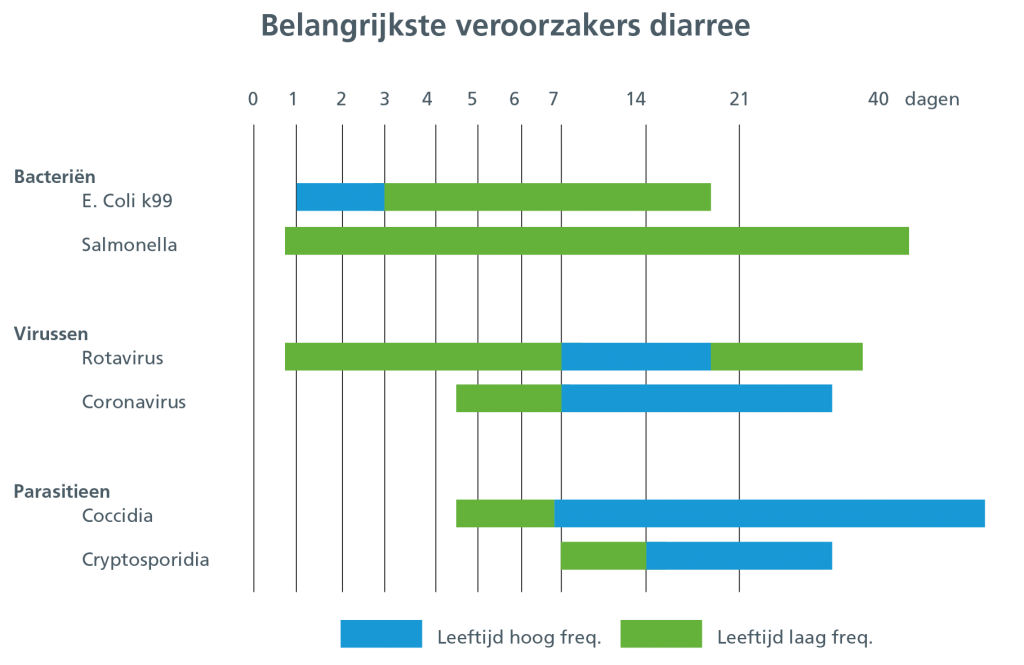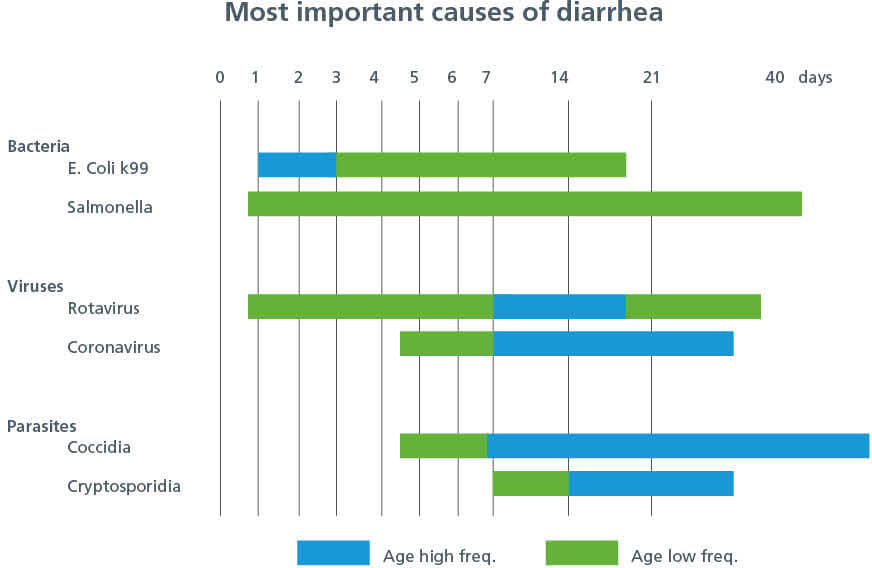Next day delivery
Order before 2:00PM
Free shipping
For orders above €100,-
Safe pay
By iDeal & Klarna
During calf rearing, it is of course important to keep the disease pressure on the farm as low as possible, so that animal health is as high as possible. Diarrhea is one of the most common ailments in young calves. Research has shown that a calf with diarrhea is 17 times more likely to have respiratory problems and that the chance of a forced culling of the dairy cow in the first lactation is 2.5 times greater (Antonis et al. 2017). This has significant financial consequences for the dairy farmer. In addition, German research shows that an outbreak of diarrhea costs between € 75 and € 145 (Lührmann 2009). Only costs for medicines, electrolyte drinks and veterinary visits are included.
The growth retardation caused by diarrhea also costs money. Less growth often means a later moment of insemination and calving and less milk production when the heifer enters lactation. Research shows that once a diarrhea outbreak in a heifer calf, the animal does not grow for an average of 1 week. The estimated future yield loss is another €75 per calf. So a diarrhea outbreak in a heifer calf costs an average of € 150 per calf.
Diarrhea can have several causes. Bacteria, viruses and parasites in particular can cause digestive disorders and have a huge impact on animal health. The figure below presents the most important causes, together with the period in which the different types of diarrhea occur most (Rumivar studiemiddag kalveropfok 2017).

In almost all cases, the calf loses a lot of fluid, body salts and energy. Within 1 day, the calf can lose as much as five to ten percent of its body weight in fluid (Kehoe and Heinrichs, 2005). In addition, there is a high chance that the calf will become acidic – the pH value of the blood will drop – because many buffer substances are lost. There can also be damage to the intestinal wall because some diarrhea causes produce toxins. All this results in the calf becoming dehydrated, losing weight and stunting in growth. In case of severe diarrhoea, the calf can die.
It is therefore extremely important to treat diarrhea in calves quickly and adequately. This means that the calf must be supplied with sufficient fluid, energy and body salts (electrolytes) quickly. It is also important to inhibit diarrhea and where possible to protect the intestinal wall. This can be done by feeding products such as pectins and tannins. Of course it is important to find out what the cause of diarrhea is in order to prevent the disease.
During calf rearing, it is of course important to keep disease levels as low as possible at the farm, thus ensuring as robust as possible animal health. Diarrhea is one of the most common conditions in young calves. Research shows that a calf with diarrhea has a 17 times greater chance of respiratory problems, and that the risk of compelled removal of the dairy cow in the first lactation is 2.5 times as high (Antonis et al. 2017). This has significant financial consequences for dairy farmers. Furthermore, German research suggests that an outbreak of diarrhoea costs between € 75 and € 145 (Lührmann 2009). This includes the cost of medicines, electrolytic drinks and veterinary visits.
But the growth delay caused by diarrhea also costs money. Lower growth often means a later moment of insemination and calving and lower milk production when the heifer enters lactation. Research shows that a diarrhoea outbreak in a heifer calf results in that calf not growing for 1 week. The estimated future yield loss is another € 75 per calf. A diarrhea outbreak in a heifer calf thus costs on average € 150 per calf.
Diarrhea can have different causes. Specifically bacteria, viruses and parasites can cause digestive disorders and have an enormous impact on animal health. The figure below presents the key causes, including the period in which the different types of diarrhea occur most (Rumivar studiemiddag kalveropfok 2017).

In almost all cases, the calf loses a lot of fluid, bodily salts and energy. Within 1 day, a calf can lose up to ten percent of its body weight in fluids (Kehoe & Heinrichs, 2005). Furthermore, there is a greater chance that the calf acidifies – the pH value of the blood falls – as it loses a lot of alkalinity. The intestinal wall may also be damaged and a number of diarrhea-causing pathogens produce toxins. This all results in the calf dehydrating, losing weight and suffering growth retardation.
In the case of severe diarrhea, the calf may even die. It is therefore extremely important to treat diarrhea in calves quickly and adequately. This means that the calf must receive sufficient fluids, energy and bodily salts (electrolytes) as soon as possible. It is also important to stem the diarrhea and where possible protect the intestinal wall. This can be done by feeding the calf products like pectins and tannins. It is of course also essential to ascertain the cause of the diarrhea to prevent further spread or repetition of the disease.
